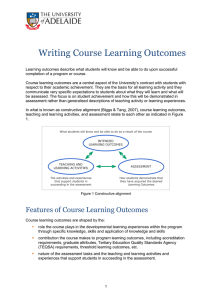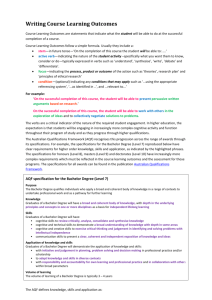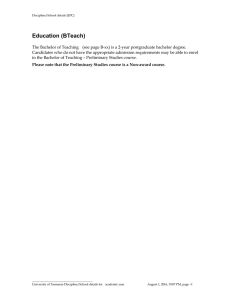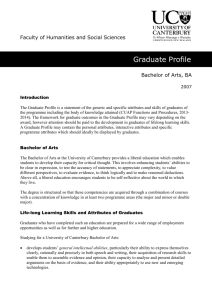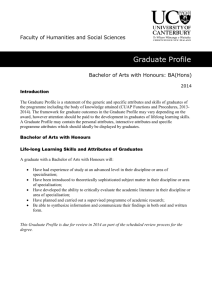Writing Program Learning Outcomes
advertisement
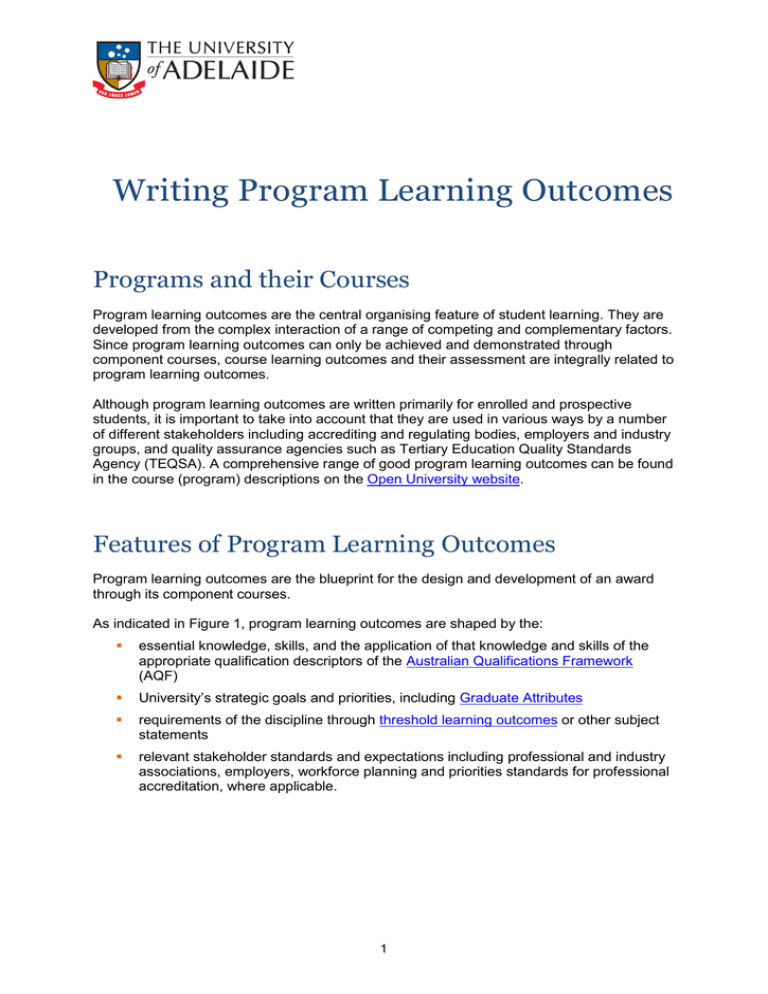
Writing Program Learning Outcomes Programs and their Courses Program learning outcomes are the central organising feature of student learning. They are developed from the complex interaction of a range of competing and complementary factors. Since program learning outcomes can only be achieved and demonstrated through component courses, course learning outcomes and their assessment are integrally related to program learning outcomes. Although program learning outcomes are written primarily for enrolled and prospective students, it is important to take into account that they are used in various ways by a number of different stakeholders including accrediting and regulating bodies, employers and industry groups, and quality assurance agencies such as Tertiary Education Quality Standards Agency (TEQSA). A comprehensive range of good program learning outcomes can be found in the course (program) descriptions on the Open University website. Features of Program Learning Outcomes Program learning outcomes are the blueprint for the design and development of an award through its component courses. As indicated in Figure 1, program learning outcomes are shaped by the: essential knowledge, skills, and the application of that knowledge and skills of the appropriate qualification descriptors of the Australian Qualifications Framework (AQF) University’s strategic goals and priorities, including Graduate Attributes requirements of the discipline through threshold learning outcomes or other subject statements relevant stakeholder standards and expectations including professional and industry associations, employers, workforce planning and priorities standards for professional accreditation, where applicable. 1 Figure 1 Relationship between Program and Course Learning Outcomes Program learning outcomes have particular characteristics. They: define the scope and depth of the program focus on the end-point of the program are framed at a high level of generalisation use language that is comprehensible to students and prospective students identify what ‘typical’ students will know and be able to do on graduation are measurable, realistic and achievable within the context and timeframe are realised through component courses over the extent of the program are demonstrated through course assessment, particularly in final year courses, and especially through capstones. Meeting TEQSA Requirements All university programs must meet the Australian Government requirements as identified in the TEQSA Threshold Standards which describe the broad parameters for quality program design at various qualification levels as outlined in the AQF. Program learning outcomes include knowledge, skills, and the application of that knowledge and skills. For example, Figure 2 is the AQF Qualification Type Descriptor for the Bachelor Degree. Full details of AQF Qualification Type Descriptors can be found at http://www.aqf.edu.au/. 2 AQF specification for the Bachelor Degree (Level 7) Purpose The Bachelor Degree qualifies individuals who apply a broad and coherent body of knowledge in a range of contexts to undertake professional work and as a pathway for further learning. Knowledge Graduates of a Bachelor Degree will have a broad and coherent body of knowledge, with depth in the underlying principles and concepts in one or more disciplines as a basis for independent lifelong learning. Skills Graduates of a Bachelor Degree will have: • cognitive skills to review critically, analyse, consolidate and synthesise knowledge • cognitive and technical skills to demonstrate a broad understanding of knowledge with depth in some areas • cognitive and creative skills to exercise critical thinking and judgement in identifying and solving problems with intellectual independence • communication skills to present a clear, coherent and independent exposition of knowledge and ideas. Application of knowledge and skills Graduates of a Bachelor Degree will demonstrate the application of knowledge and skills: • with initiative and judgement in planning, problem solving and decision making in professional practice and/or scholarship • to adapt knowledge and skills in diverse contexts • with responsibility and accountability for own learning and professional practice and in collaboration with others within broad parameters. Volume of learning The volume of learning of a Bachelor Degree is typically 3 – 4 years. Figure 2 AQF Specification for the Bachelor Degree (Level 7) The AQF defines knowledge skills and application as: Knowledge is what a graduate knows and understands. It is described in terms of depth, breadth, kinds of knowledge and complexity, as follows: depth of knowledge can be general or specialised breadth of knowledge can range from a single topic to multi-disciplinary area of knowledge kinds of knowledge range from concrete to abstract, from segmented to cumulative complexity of knowledge refers to the combination of kinds, depth and breadth of knowledge. Skills are what a graduate can do. Skills are described in terms of the kinds and complexity of skills and include: cognitive and creative skills involving the use of intuitive, logical and critical thinking technical skills involving dexterity and the use of methods, materials, tools and instruments communication skills involving written, oral, literacy and numeracy skills interpersonal skills and generic skills. Application of knowledge and skills is the context in which a graduate applies knowledge and skills. Specifically: application is expressed in terms of autonomy, responsibility and accountability the context may range from the predictable to the unpredictable, and the known to the unknown, while tasks may range from routine to non-routine. 3 Meeting Discipline Standards Programs are expected to meet the threshold learning outcomes for their disciplines which are being progressively developed nationally. Details can be found at: http://disciplinestandards.pbworks.com/w/page/52657697/FrontPage Constructing Program Learning Outcomes Statements All programs are subject to multiple (and sometimes conflicting) curriculum demands from accreditation groups, University priorities, discipline standards, etc., and no single framework meets all of these demands. A practical way to approach the task of writing program learning outcomes is to choose one of the required curriculum frameworks and to integrate the other demands/frameworks into it. Where programs are accredited it may be useful to begin with the framework provided by the accrediting group and then to incorporate the other components. Where the curriculum is not subject to accreditation, the University's graduate attributes or the threshold learning outcomes (where they exist) provide a valuable starting point. The final statements should meet the specifications of all required frameworks but may not include all discretionary aspects identified by stakeholders because of conflicts with required elements or other considerations. Feedback to stakeholders should include a rationale for the excluded aspects. Because program learning outcomes identify the minimum that students need in order to be successful in the award, they must be attainable by a ‘typical’ student in a reasonable timeframe while engaging in supportive learning processes. Assessment rubrics make provision for a range of attainment but pass levels in the final year of the award should be tied to program learning outcomes. Effective program and course learning outcomes are written using the following structure: Stem a leading statement in the future tense, highlighting that the following actions are expected to be achieved by students by the end of the period of study Active verb indicating specifically what you want students to know, consider or do Focus / Object indicating the process, product or outcome of the action such as ‘theories’, ‘research plan’ and ‘principles of ethical research’ Context/Condition/Qualifier (optional) indicating any conditions that may apply such as ‘...using the appropriate referencing system’, ‘...as identified in ..’, and ...relevant to...’ Some examples of effective program learning outcomes On successful completion of this program graduates will be able to: ...apply the major theories and research procedures to contemporary social problems. …conduct practical or practice-based tasks in a responsible, safe and ethical manner taking proper account of risk assessment and health and safety regulations. …use established ideas, concepts and techniques, drawn from the study of business/organisations, to analyse a wide range of work-related problems and issues. 4 Bloom’s Taxonomy In learning outcomes statements, verbs are a critical indicator of the nature of the required student engagement. In higher education, the expectation is that students will be pursuing increasingly more complex cognitive activity and function throughout their program of study and as they progress through higher qualifications. The AQF recognises this progression across the range of awards through its specifications which need to be reflected in program and course learning outcomes and assessment. The AQF specifications for all awards can be found at http://www.aqf.edu.au/wpcontent/uploads/2013/05/AQF-2nd-Edition-January-2013.pdf. Bloom’s Taxonomy provides a list of verbs with increasing levels of complexity in cognitive activity and function. These can be used to specify the nature of student learning activity. Verbs using Bloom’s Taxonomy Knowledge recall, record, list, reproduce, arrange, memorise, define, outline, state, recognise, relate, describe, identify, show, examine, present, quote, name, duplicate, tabulate. Comprehension restate ,discuss, clarify, locate, recognise, classify, translate, explain, express, review, interpret, select, summarise, contrast, predict, associate, estimate, extend. Application demonstrate, schedule, operate, dramatise, apply, employ, use, practise, illustrate, choose, solve, write, calculate, complete, show, examine, modify, relate, classify, experiment. Analysis distinguish, differentiate, investigate, categorise, appraise, inspect, test, debate, compare, contrast, question, criticise, solve, analyse, separate, order, connect, explain, calculate, relate. Synthesis compose, assemble, organise, plan, collect, propose, construct, design, create, formulate, arrange, devise, modify, derive, develop, integrate, rearrange, substitute, invent, generalise. Evaluation judge, score, select, evaluate, choose, rate, assess, compare, estimate, value, measure, discriminate, argue, defend, support, recommend, conclude, summarise, appraise, revise. Key Questions When writing the program learning outcomes you might find it useful to keep in mind the following key questions: What are the most important aspects of the discipline that your graduates need to know and do as a result of completing this program? How does this compare with program learning outcomes for similar programs at other comparable universities (e.g. Go8s)? What is your rationale for including the identified aspects of the discipline? What is your rationale for excluding aspects of the discipline that are included in other similar awards or which are valued by stakeholders? Are the program learning outcomes indicative of the expectations of a graduate at the relevant level in the Australian Qualifications Framework? Do the program learning outcomes incorporate the University's graduate attributes? 5 How do the statements reference stakeholder views, including accrediting bodies? Which component courses provide the opportunity to demonstrate achievement of the program learning outcomes through assessment? Are the statements broad enough to allow the achievement of the outcomes to be demonstrated through a variety of approaches and experiences? Are the statements specific enough to determine whether minimum standards have been met? Do the statements take account of the interests of the range of stakeholders (TEQSA, accrediting bodies, employers, etc.)? Are the program learning outcomes expressed in terms of: o stem – in future tense: 'On the completion of this program the graduates will be able to: ...' o active verb – indicating the nature of the student activity—specifically what you want them to know, consider or do—typically expressed in verbs such as 'understand', 'synthesise', 'write', 'debate' and 'differentiate' o focus – indicating the process, product or outcome of the action such as 'theories', 'research plan' and 'principles of ethical research' o condition – (optional) indicating any conditions that may apply such as '...using the appropriate referencing system', '...as identified in ...', and '...relevant to...' The University of Adelaide 2014 6
